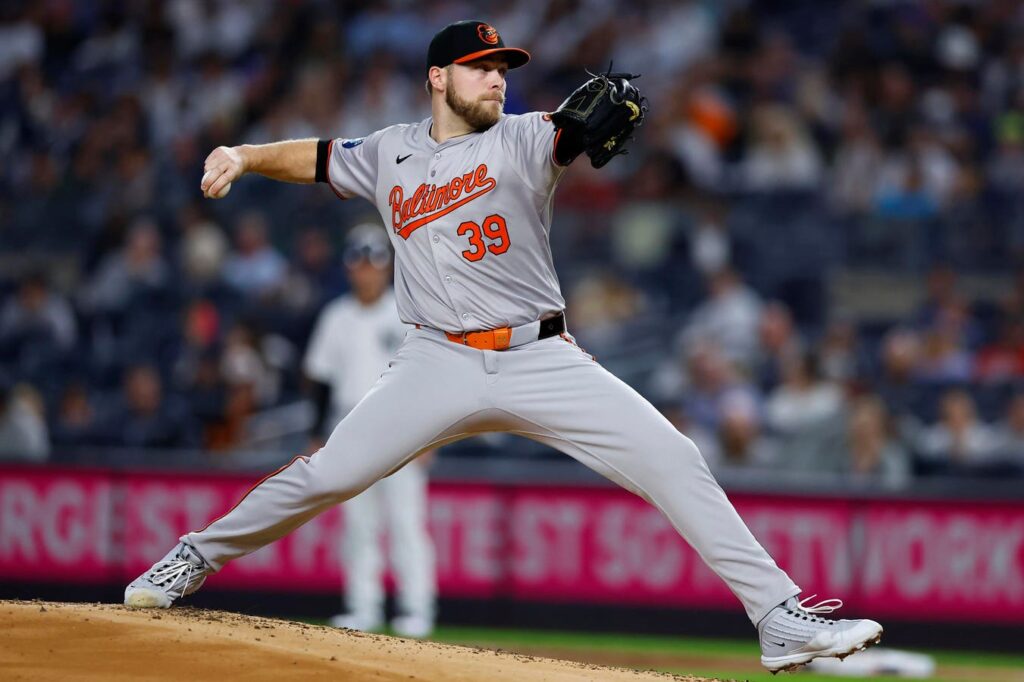FILE – Baltimore Orioles’ Corbin Burnes pitches during the first inning of a baseball game against … [+]
The Arizona Diamondbacks made their biggest splash off the offseason late last night. They agreed to terms with free agent starting pitcher Corbin Burnes on a six-year, $210 million deal with an opt-out after the 2026 season according to Jon Heyman of the New York Post.
Burnes established himself as one of baseball’s best arms with the Milwaukee Brewers where he pitched from 2018-2023, winning the Cy Young Award in 2021. A year ago, they traded him to the Baltimore Orioles for DL Hall, Joey Ortiz, and a draft pick.
His durability, consistency, and excellence on the mound headline his resume. Since becoming a full-time starter in 2021, he averaged 31 starts and 189 innings pitched per year with a 2.94 ERA. He made the All-Star team in all four of those campaigns.
Burnes’ $35 million average annual salary will almost certainly be the highest any pitcher receives this winter. In early November, MLB Trade Rumors ranked the 30-year-old as the top pitcher in the free agent class and the second-best player overall behind Juan Soto. The two other front-line hurlers available already found new homes—Max Fried joined the New York Yankees on an eight-year, $218 million contract and Blake Snell signed with the Los Angeles Dodgers for five years and $182 million (deferrals bring down his average annual value below Burnes’).
All large contracts carry inherent risk, but despite how good he has been in his career so far, there are cracks in his profile. His strikeout rate has dropped alarmingly ever since he won the Cy Young. It was 35.6% in 2021, 30.5% in 2022, 25.5% in 2023, and 23.1% in 2024. The MLB average was 22.6% last year, so he was just slightly above it instead of blowing past it like he did four years ago.
Burnes lives and dies by his cutter. He threw it more than 50% of the time from 2021-2023 and 45% of the time last season, and he led all starting pitchers in cutter usage in all four years. While it’s still an excellent pitch, it doesn’t generate swinging strikes as often as it used to do when he was in Milwaukee. It’s simultaneously the secret to his success and the culprit for his decline, which is why he started using his slider and curveball more often in Baltimore. Evidently, the Diamondbacks aren’t concerned by his rapidly dropping strikeout rate or that his main weapon is now more of a pitch-to-contact offering.
Perhaps more than any other franchise, Arizona’s history has been defined by big contracts for pitchers in free agency. They signed Randy Johnson to a four-year deal in 1999 and he won the Cy Young in all four seasons, leading them to their only championship in 2001—just four years after they were founded. The other side of that coin is the five-year contract with Madison Bumgarner which was an immediate disaster and led to his release in April of the fourth year of the deal. They had payroll space to sign Burnes in part because they’re finally free of their obligations to Bumgarner following the 2024 season.
Their current rotation has been shaped in free agency as well. Burnes will join Merrill Kelly and Eduardo Rodriguez, who were both signed on the open market in previous years. His signing also could kick Jordan Montgomery out to the bullpen. He signed with them at the end of March for $25 million with a $22.5 million player option for 2025, which he exercised after flopping with a 6.23 ERA last year.
Burnes declined a qualifying offer from the Orioles, so they will receive draft-pick compensation for losing him. They will have to turn elsewhere—internally or externally—to replace him with a new ace.
The Diamondbacks just missed the playoffs last season with an 89-73 record—just a year after reaching the World Series following an 84-78 regular season. Their commitment to Burnes should help them keep pace in an increasingly competitive National League playoff race—as long as his cutter reverses its trend and doesn’t become too hittable.


